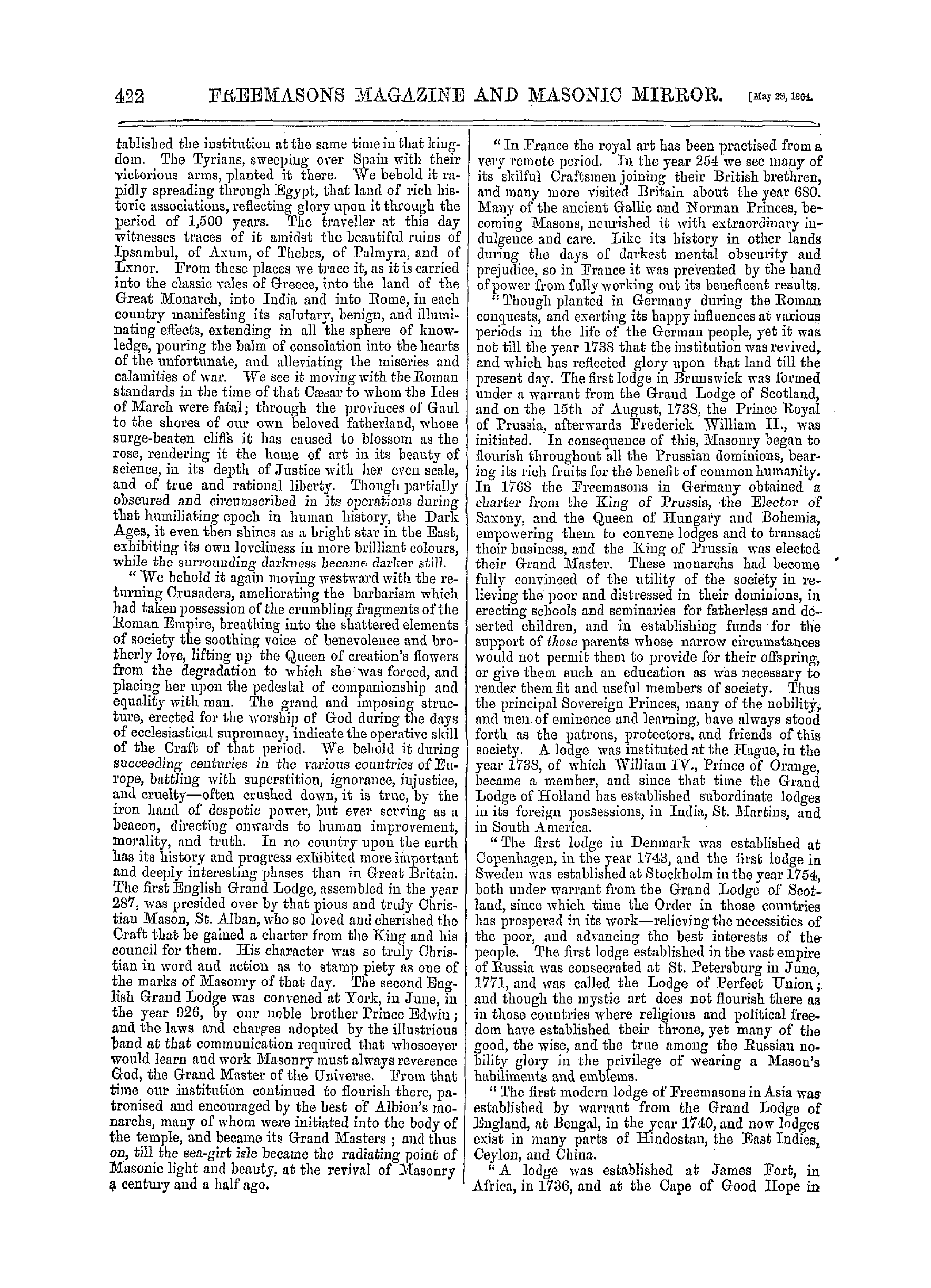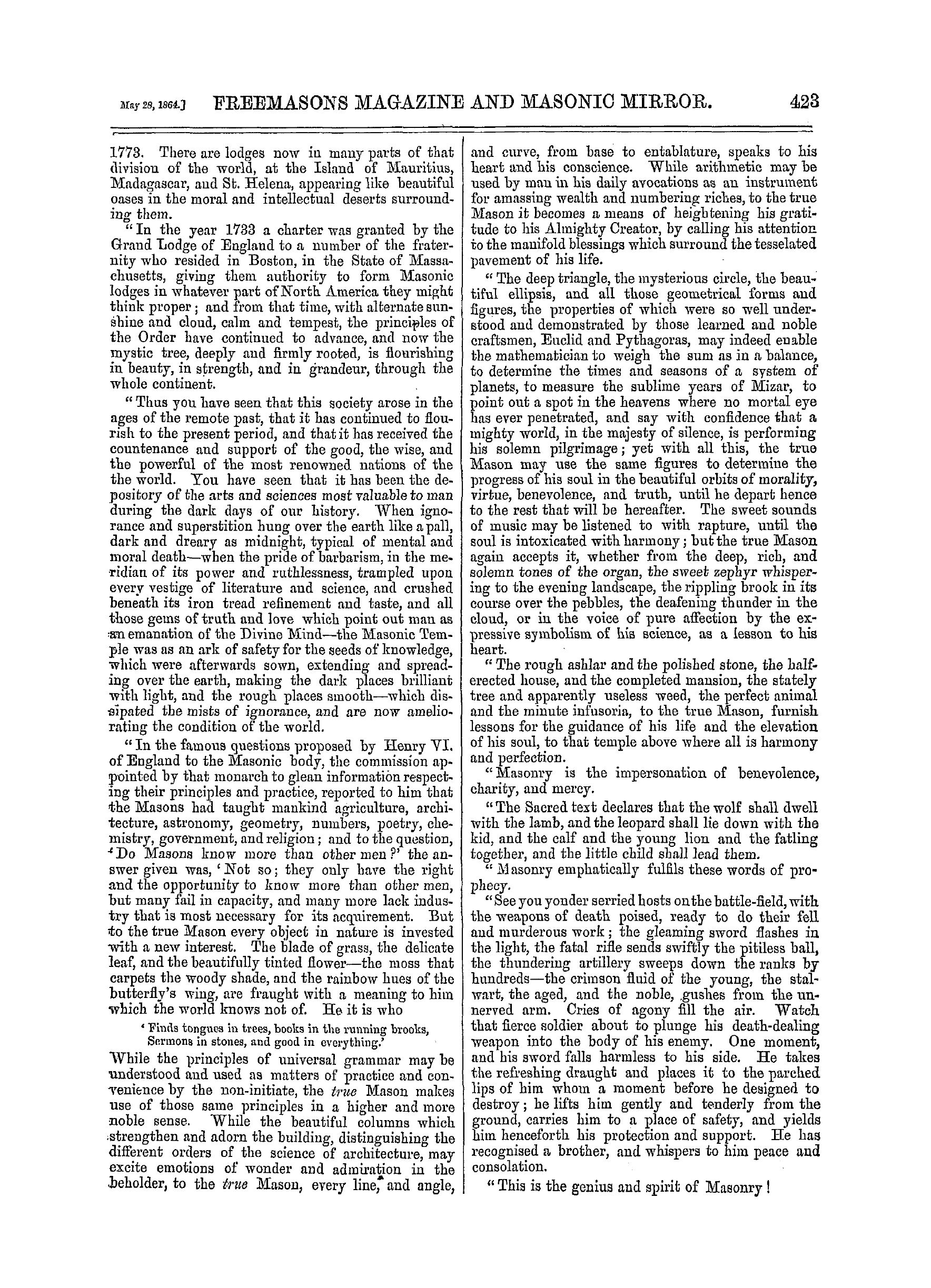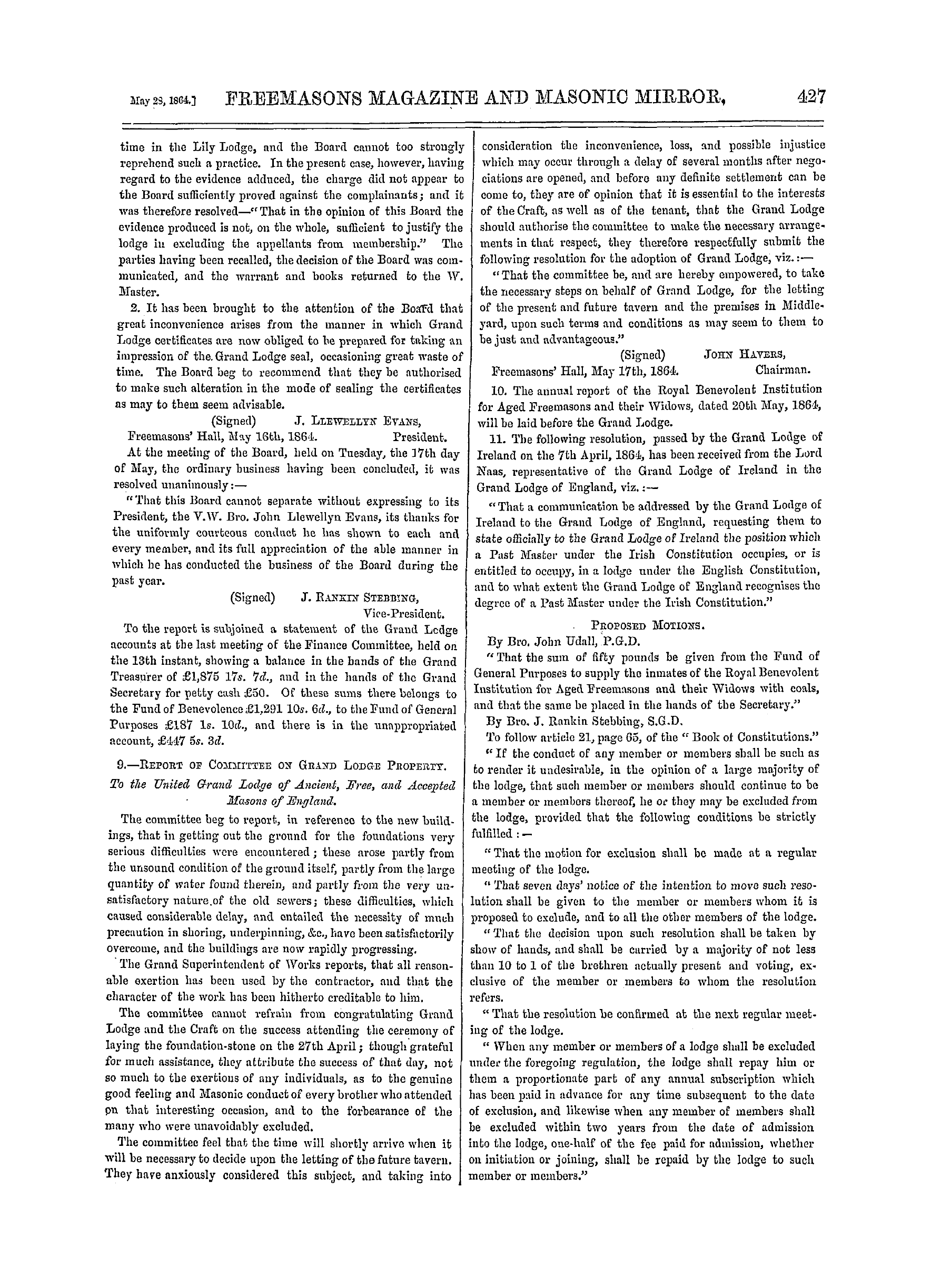-
Articles/Ads
Article THE INTERIOR OF A GOTHIC MINSTER.* ← Page 4 of 5 →
Note: This text has been automatically extracted via Optical Character Recognition (OCR) software.
The Interior Of A Gothic Minster.*
and Westminster ; in the firstbay at Ely , Gloucester , Tintern , Fountains , Chichester , Christchurch , and Chester . At Fountains , a curious range of pottery was found in connection with it ; but it is very doubtful whether it was designed on acoustic principles , or was part of a system of warming
as charcoal was found in the urns . At Exeter , Lincoln , York , Carlisle , Canterbury , Rochester , Lichfield , and Oxford ( and Christchurch , Hants , in late Decorated times ) , the screen appeared under the eastern , and at Hereford below the western arch of the lantern ; but the central tower was at
length almost universally regarded as the natural division between the nave and choir , and the screen placed in consequence between its eastern pillars : hence its name of rood-tower at Lincoln and Hereford .
In the early part of the twelfth century , a stone screen , with a central altar of St . Cuthbert , was erected at St . Alban's , stretching between the two second bays westward from the lantern . In the thirteenth century a more magnificent screen was erected , formed so as to enclose this altar , in
the next bay westward , ; it had side processionaldoors , and windows pierced in its partition walls . In order to compensate for the limited accommodation afforded by the dormitory , the chapel was furnished above the vaulting with an upper chambercontaining about twelve bedslighted
, , by windows , and covered by a leaded ceiling . At WjTnondham , there was a dormitory over the south nave-aisle . In the reign of Edward I . the present screen was erected , the altar of St . Cuthbert standing unenclosedbetweenthe two doorways . The second screen at St . Alban ' s must have
resembled the arrangement of the screens at Gloucester , St . David's , and Norwich , consisting of a front and inner wall , separated by a considerable interval ; possibly one carried a rood and the other supported au ambon . The screen not only served to exclude draughts of cold air and seclude
the choir , but also took the place of the double ambones , of the basilica , and from its summit the Gospel and Epistle were read ( Martene , . do Ant . Mon . Rit ., iv ., 143 , 96 ) . Ciompini dates the desuetude of the ambones from the time of the
removal of the popes , to Avignon , in 1309 . It was called ambo ( Socrates , lib . iv ., c . 5 ) , from its stairs , tic TOV avafiaiveiv ( ab anibiendo quia intrautem ambit!—W . Strabo , c . 5 ) , or pulpitimn ( S . Cypr ., ep . xxxiii ., xxxit . ) ( Quod sit in publica statuendum , ut qui ibi stant ab omnibus videantur . W .
Strabo , u . s ) . The bishops used it for preaching , and the lectors for reading the Epistle and Gospel ; in Cranmer ' s time the latter were read from the pulpit ( Works , ii . 156 , 501 ; Grindal i . 132 ) . The rood-stairs corresponded to those of the ambo . At PeterboroughAdam de Boothbon
, y , his election to be abbot , was carried on the monks ' shoulders to the hi gh altar , and thence to the loft , where he was proclaimed ( Comp . Martene , de Ant . Mon . Rit ., iv . 232 ; ii . 154 , 159 ) .
The Altar of Jesus or Holy Cross ( Willis , Mitred Abbeys , i . 320 ) usually stood below the great rood or cross . At Exeter the Lady Mass at break of clay , ancl at Salisbury the Matin Mass was suns- at the rood altar for the convenience of
the working people . A lamp burned perpetually before the rood . A common arrangement of the screen was that of a central doorway between two altar-recesses , as at Exeter , 1370-95 ; Chichester , 1447 ; Lincoln , 1310 ; Winchester ; Chester fourteenth century ; Brecon ; St . David ' s , fourteenth
century ; Norwich , fifteenth century , and Hereford . At Winchester , the choir platform erected over the crypt extends into the nave , and is ascended by superb flights of stairs : it has been suggested that this space was canopied above the lateral altars . At Hereford the vicars received
their dole here , and at Exeter ' offending vicars were compelled to stand during all the canonical hours of a single day and night . At Durham , athwart the east end of the nave , between the western pillars of the lantern , stood the Jesus altar wholly enclosed like a porchwith wainscot-work ,
, at which the Jesus Mass was sung on Fridays , and the Jesus Anthem , led by the master of the choristers and deacons , on Friday nights during the tolling , of the Galilee bells after evensong . It faced westward , with a small doorway at each side
of the screen which formed its reredos leading into the transept . On the north side were an organ and loft for the singers . Above the screen was the great rood ; with St . Mary and John and adoring angels rising over sculptures of the Passion and apostles , and a broad band of foliage .
Behind the screen and under the lantern was the clock . The north rood door was only opened for processions . The screen , like that of Chester , was painted with portraits of English kings and worthies . The choir-door was in the screen between the eastern tower pillars , over which
were the great organs , used only on chief days , and the pulpit for singing the Nine Sections in the nocturns of principal feasts . Below the left was a form on which men might rest themselves . A tall square-stone pedestal stood adjoining the south-east pillarfor the support of twelve cressets
, , one of which was lighted at midnight during Lauds . At Norwich , St . William ' s altar was on the north , and St . Mary's , or the Precentor ' s , on the south side , enclosed with wooden screens . In the interval between the outer walls stood the altar of our Lady of Pity .
The other arrangement of the roodscreen was that of a central door set in a wall , which existed at Gloucester ( of the fourteenth century , and destroyed with its pulpit in 1718 ) ; Canterbury , 1304 ; Wells , decorated ; Salisbury ; Chester , fourteenth century ; Riponafter 1489 ; Worcester
, , fifteenth century ; Carlisle and Lincoln , fifteenth century ; Christchurch , temp . Edward III . ; and York , temp . Henry YI . At Worcester , on the western riiers of the lantern , are stone brackets
Note: This text has been automatically extracted via Optical Character Recognition (OCR) software.
The Interior Of A Gothic Minster.*
and Westminster ; in the firstbay at Ely , Gloucester , Tintern , Fountains , Chichester , Christchurch , and Chester . At Fountains , a curious range of pottery was found in connection with it ; but it is very doubtful whether it was designed on acoustic principles , or was part of a system of warming
as charcoal was found in the urns . At Exeter , Lincoln , York , Carlisle , Canterbury , Rochester , Lichfield , and Oxford ( and Christchurch , Hants , in late Decorated times ) , the screen appeared under the eastern , and at Hereford below the western arch of the lantern ; but the central tower was at
length almost universally regarded as the natural division between the nave and choir , and the screen placed in consequence between its eastern pillars : hence its name of rood-tower at Lincoln and Hereford .
In the early part of the twelfth century , a stone screen , with a central altar of St . Cuthbert , was erected at St . Alban's , stretching between the two second bays westward from the lantern . In the thirteenth century a more magnificent screen was erected , formed so as to enclose this altar , in
the next bay westward , ; it had side processionaldoors , and windows pierced in its partition walls . In order to compensate for the limited accommodation afforded by the dormitory , the chapel was furnished above the vaulting with an upper chambercontaining about twelve bedslighted
, , by windows , and covered by a leaded ceiling . At WjTnondham , there was a dormitory over the south nave-aisle . In the reign of Edward I . the present screen was erected , the altar of St . Cuthbert standing unenclosedbetweenthe two doorways . The second screen at St . Alban ' s must have
resembled the arrangement of the screens at Gloucester , St . David's , and Norwich , consisting of a front and inner wall , separated by a considerable interval ; possibly one carried a rood and the other supported au ambon . The screen not only served to exclude draughts of cold air and seclude
the choir , but also took the place of the double ambones , of the basilica , and from its summit the Gospel and Epistle were read ( Martene , . do Ant . Mon . Rit ., iv ., 143 , 96 ) . Ciompini dates the desuetude of the ambones from the time of the
removal of the popes , to Avignon , in 1309 . It was called ambo ( Socrates , lib . iv ., c . 5 ) , from its stairs , tic TOV avafiaiveiv ( ab anibiendo quia intrautem ambit!—W . Strabo , c . 5 ) , or pulpitimn ( S . Cypr ., ep . xxxiii ., xxxit . ) ( Quod sit in publica statuendum , ut qui ibi stant ab omnibus videantur . W .
Strabo , u . s ) . The bishops used it for preaching , and the lectors for reading the Epistle and Gospel ; in Cranmer ' s time the latter were read from the pulpit ( Works , ii . 156 , 501 ; Grindal i . 132 ) . The rood-stairs corresponded to those of the ambo . At PeterboroughAdam de Boothbon
, y , his election to be abbot , was carried on the monks ' shoulders to the hi gh altar , and thence to the loft , where he was proclaimed ( Comp . Martene , de Ant . Mon . Rit ., iv . 232 ; ii . 154 , 159 ) .
The Altar of Jesus or Holy Cross ( Willis , Mitred Abbeys , i . 320 ) usually stood below the great rood or cross . At Exeter the Lady Mass at break of clay , ancl at Salisbury the Matin Mass was suns- at the rood altar for the convenience of
the working people . A lamp burned perpetually before the rood . A common arrangement of the screen was that of a central doorway between two altar-recesses , as at Exeter , 1370-95 ; Chichester , 1447 ; Lincoln , 1310 ; Winchester ; Chester fourteenth century ; Brecon ; St . David ' s , fourteenth
century ; Norwich , fifteenth century , and Hereford . At Winchester , the choir platform erected over the crypt extends into the nave , and is ascended by superb flights of stairs : it has been suggested that this space was canopied above the lateral altars . At Hereford the vicars received
their dole here , and at Exeter ' offending vicars were compelled to stand during all the canonical hours of a single day and night . At Durham , athwart the east end of the nave , between the western pillars of the lantern , stood the Jesus altar wholly enclosed like a porchwith wainscot-work ,
, at which the Jesus Mass was sung on Fridays , and the Jesus Anthem , led by the master of the choristers and deacons , on Friday nights during the tolling , of the Galilee bells after evensong . It faced westward , with a small doorway at each side
of the screen which formed its reredos leading into the transept . On the north side were an organ and loft for the singers . Above the screen was the great rood ; with St . Mary and John and adoring angels rising over sculptures of the Passion and apostles , and a broad band of foliage .
Behind the screen and under the lantern was the clock . The north rood door was only opened for processions . The screen , like that of Chester , was painted with portraits of English kings and worthies . The choir-door was in the screen between the eastern tower pillars , over which
were the great organs , used only on chief days , and the pulpit for singing the Nine Sections in the nocturns of principal feasts . Below the left was a form on which men might rest themselves . A tall square-stone pedestal stood adjoining the south-east pillarfor the support of twelve cressets
, , one of which was lighted at midnight during Lauds . At Norwich , St . William ' s altar was on the north , and St . Mary's , or the Precentor ' s , on the south side , enclosed with wooden screens . In the interval between the outer walls stood the altar of our Lady of Pity .
The other arrangement of the roodscreen was that of a central door set in a wall , which existed at Gloucester ( of the fourteenth century , and destroyed with its pulpit in 1718 ) ; Canterbury , 1304 ; Wells , decorated ; Salisbury ; Chester , fourteenth century ; Riponafter 1489 ; Worcester
, , fifteenth century ; Carlisle and Lincoln , fifteenth century ; Christchurch , temp . Edward III . ; and York , temp . Henry YI . At Worcester , on the western riiers of the lantern , are stone brackets



















